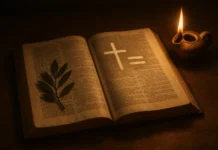 What Was Mary’s Lineage in the Bible
What Was Mary’s Lineage in the Bible
When we open the Bible and trace the story of Jesus’ earthly family, Mary, His mother, stands at the center. But what do we really know about Mary’s lineage in the Bible? Where did she come from? Who were her ancestors? And why does her family line matter so much in God’s plan of salvation?
This is a question that takes us deep into Scripture, Jewish tradition, and the promises of God that were fulfilled through her son, Jesus Christ. Let’s walk slowly through the story of Mary’s family tree, keeping our eyes on how it connects to King David and the hope of the Messiah.
Mary’s Place in God’s Plan
Mary’s role in the story of redemption is unlike anyone else’s. She was chosen by God to be the mother of Jesus, the Savior of the world. Luke tells us she was “highly favored” (Luke 1:28), a humble young woman from Nazareth, a small town in Galilee.
But her calling wasn’t random. God had prepared her family line long before she was born. The Old Testament prophets had already spoken of a Messiah who would come through the line of David. If Jesus was to fulfill the prophecies, His earthly heritage had to be rooted in the house of David. That’s where Mary’s lineage becomes so important.
Two Genealogies: Matthew and Luke
If you’ve ever read the New Testament carefully, you might have noticed that there are two different genealogies of Jesus, one in Matthew 1 and the other in Luke 3. At first glance, they don’t look the same. Matthew traces the line from Abraham down to Joseph, while Luke traces from Jesus backward all the way to Adam.
So which one shows Mary’s lineage? This has been debated for centuries. Most scholars agree that Matthew’s genealogy records the legal line through Joseph, while Luke’s genealogy reflects the biological line, Mary’s side of the family.
Matthew’s genealogy shows Jesus as the legal heir to David’s throne through Joseph, His adoptive father.
Luke’s genealogy most likely reflects Mary’s bloodline, showing that Jesus was physically descended from David through her.
This way, both the legal and biological requirements of the Messiah’s lineage were fulfilled.
Mary’s Lineage in Luke
Luke 3:23–38 lists the names from Jesus all the way back to Adam. But one detail stands out: it says Jesus was “the son, as was supposed, of Joseph, the son of Heli” (Luke 3:23). Many early church writers believed Heli was actually Mary’s father, making Joseph his son-in-law.
This would mean Luke’s genealogy quietly shifts from Joseph to Mary’s family line. Instead of tracing Joseph’s natural ancestors, it follows Mary’s blood relatives. Through this, we see that Mary herself was a descendant of King David.
According to Luke, Mary’s line runs through David’s son Nathan, not Solomon. That distinction matters because it shows how God worked in two separate but connected ways: Joseph’s line (through Solomon) gave Jesus the legal right to David’s throne, and Mary’s line (through Nathan) gave Him the biological connection to David.
Mary’s Parents According to Tradition
The Bible doesn’t directly name Mary’s parents. But early Christian tradition, recorded in writings such as the Protoevangelium of James, names them as Joachim and Anne. They are remembered as a devout Jewish couple who longed for a child and were blessed late in life with Mary.
While this tradition isn’t part of the Bible itself, it helps us understand how the early church cherished Mary’s story. Her parents were said to come from the tribe of Judah, the same tribe as King David. This matches the prophetic expectation that the Messiah would be born from Judah (Genesis 49:10).
Did Mary and Joseph Share the Same Lineage?
Yes, in a way. Both Mary and Joseph were from the tribe of Judah and descended from King David. But their family lines split along different branches of David’s family tree.
Joseph’s line went through Solomon, David’s royal heir (Matthew 1).
Mary’s line went through Nathan, another son of David (Luke 3).
This shows a beautiful detail of God’s plan. Both parents, though from different branches, carried David’s bloodline. It confirmed beyond doubt that Jesus was the promised Son of David, both legally and biologically.
The Importance of the Davidic Line
Why does it matter so much that Mary’s lineage went back to David? Because the Old Testament repeatedly promised that the Messiah would come from David’s house.
God told David: “Your house and your kingdom shall endure forever before me; your throne shall be established forever” (2 Samuel 7:16).
Isaiah prophesied: “A shoot will come up from the stump of Jesse” (Isaiah 11:1). Jesse was David’s father, and the “shoot” refers to the Messiah.
Jeremiah declared: “The days are coming when I will raise up for David a righteous Branch” (Jeremiah 23:5).
By being born of Mary, who carried David’s bloodline, Jesus fulfilled these promises.
Was Mary Genetically Related to Jesus?
This is a question that makes us pause. Jesus was conceived by the Holy Spirit (Luke 1:35), which means His birth was a miracle beyond natural explanation. Yet, He was truly born of Mary. He shared her flesh, her humanity, her connection to David’s family.
So yes, Jesus was physically related to Mary. She gave Him His human nature. At the same time, His divine nature came from God. This union of divinity and humanity is at the very heart of the Christian faith.
Who Was Mary’s Father in the Bible?
The Bible doesn’t give us Mary’s father’s name directly. As mentioned, Luke 3:23 refers to “Heli,” and many believe this was Mary’s father. Others see Heli as Joseph’s father by another tradition.
The most consistent understanding is that Heli was Mary’s father, which fits with the idea that Luke’s genealogy follows her family line. This way, Jesus is connected through His mother to Heli, and through him back to David.
The Humble Roots of Mary
Even though Mary’s ancestry tied her to King David, she lived a very humble life. Nazareth, her hometown, was small and insignificant. When Nathanael first heard of Jesus of Nazareth, he asked, “Can anything good come out of Nazareth?” (John 1:46).
This contrast between royal ancestry and humble living shows the humility of God’s plan. Jesus, though a King by blood and destiny, was born in a manger, raised in a carpenter’s home, and lived among ordinary people. Mary’s life reminds us that God’s promises can unfold in the quietest of places.
Why Mary’s Lineage Still Matters Today
Mary’s genealogy isn’t just a list of names. It’s a testimony that God keeps His promises. The Messiah came exactly as foretold, through David’s family, through the tribe of Judah, through a humble young woman named Mary.
Her lineage also teaches us that God values faithfulness across generations. For centuries, Israel held on to the hope of the Messiah. When the time came, God fulfilled His word. That should encourage us today: the promises of God never fail, no matter how long they take.
Bringing It All Together
Mary’s lineage connects her to King David through Nathan (Luke 3).
Joseph’s lineage connects him to David through Solomon (Matthew 1).
Both lineages show Jesus’ right to David’s throne, legally and biologically.
Tradition names Mary’s parents as Joachim and Anne, linking her to Judah’s tribe.
Jesus was truly born of Mary, sharing her humanity, while being the Son of God.
Closing Reflection
When you read Mary’s genealogy in the Bible, it may feel like a long list of names. But behind those names is a story of God’s faithfulness. Mary was not chosen at random; her life and family were woven into the plan of salvation from the beginning.
As we reflect on her lineage, we are reminded that God sees beyond the surface. He chooses the humble, the faithful, and the willing. Through Mary’s line, the Savior came into the world, not with royal fanfare, but with quiet grace.
And so, the story of Mary’s lineage is really the story of God’s love, reaching through generations, until the day Jesus was born in Bethlehem.













